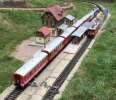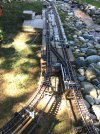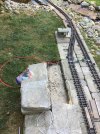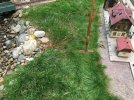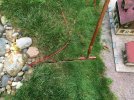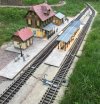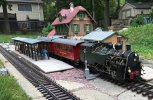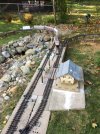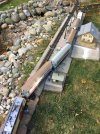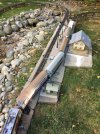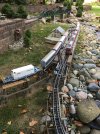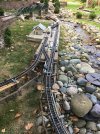I spent this afternoon putting in two IR train detectors on Track 1 of one of my RR's two stations. The sensor positions still need to be finalized and I need to install another sensor pair on Track 2. I also need to paint the sensor wires and the butt joints where I attached the sensors to indoor/outdoor 4 conductor 22 awg control cable extensions with some black "Liquid Tape". The cable will need to be buried next to the right-of-way too.
Yesterday was spent setting up/debugging the "Events" necessary for the seemingly simple task of having a train slow down, then stop at the station, depart the station on command, transit the loop, then do it all over again. I have to give credit to the author of the "Railway.zone" blog, railway.zone | The German Railway in H0, for explaining how the CS3 event macro "BRAKE" functions. I would have been completely lost without this help. After 'events" have been set up the CS3 lets them be tested without actually running a train. This is very helpful correcting errors in both programming and logic.
In any case, I was able to do some real testing with a train today which was very useful. I got to straighten out some sensor contact assignments and a few other glitches. By the end of the afternoon I had the train departing the station on command traveling around my layout, and returning to the station. I should be able to have two trains taking turns going in opposite directions around my single track mainline as soon as I install the Track 2 IR sensors.
The "Brake" macro makes automatically stopping the train in a station relatively easy without needing to install a brake module and associated isolated rail sections and wiring. This was one of my major automation objectives achieved! The macro uses the braking and acceleration settings in the locos decoder to control slowing and departure. The macro is active, when station signal for Track 1 is "red". It will slow the train to a preset setting when the first sensor is triggered. The speed is set to zero and the train stops when the second sensor is triggered. The train accelerates to its original speed when it is released by a "green" signal. Note that a real signal is not required, I created a virtual signal that gets reset to "red" after the train departs. I've got the "green" triggered by correctly setting the departure turnout for Track 1. At some future point this will be triggered by a second train having entered the station on Track 2.
I've got two more Azatrax MRD8 IR sensor modules and LGB catenary mast bases and wire holders on order to prep another bunch of IR sensor pairs for my other station and to set up block control potential. IR Train Sensors
I'm beginning to think in "train control logic" but have a long way to go!
Yesterday was spent setting up/debugging the "Events" necessary for the seemingly simple task of having a train slow down, then stop at the station, depart the station on command, transit the loop, then do it all over again. I have to give credit to the author of the "Railway.zone" blog, railway.zone | The German Railway in H0, for explaining how the CS3 event macro "BRAKE" functions. I would have been completely lost without this help. After 'events" have been set up the CS3 lets them be tested without actually running a train. This is very helpful correcting errors in both programming and logic.
In any case, I was able to do some real testing with a train today which was very useful. I got to straighten out some sensor contact assignments and a few other glitches. By the end of the afternoon I had the train departing the station on command traveling around my layout, and returning to the station. I should be able to have two trains taking turns going in opposite directions around my single track mainline as soon as I install the Track 2 IR sensors.
The "Brake" macro makes automatically stopping the train in a station relatively easy without needing to install a brake module and associated isolated rail sections and wiring. This was one of my major automation objectives achieved! The macro uses the braking and acceleration settings in the locos decoder to control slowing and departure. The macro is active, when station signal for Track 1 is "red". It will slow the train to a preset setting when the first sensor is triggered. The speed is set to zero and the train stops when the second sensor is triggered. The train accelerates to its original speed when it is released by a "green" signal. Note that a real signal is not required, I created a virtual signal that gets reset to "red" after the train departs. I've got the "green" triggered by correctly setting the departure turnout for Track 1. At some future point this will be triggered by a second train having entered the station on Track 2.
I've got two more Azatrax MRD8 IR sensor modules and LGB catenary mast bases and wire holders on order to prep another bunch of IR sensor pairs for my other station and to set up block control potential. IR Train Sensors
I'm beginning to think in "train control logic" but have a long way to go!
Last edited:

